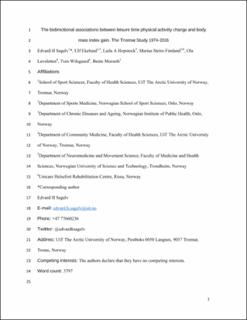The bidirectional associations between leisure time physical activity change and body mass index gain. The Tromsø Study 1974–2016
Sagelv, Edvard Hamnvik; Ekelund, Ulf; Hopstock, Laila Arnesdatter; Fimland, Marius Steiro; Løvsletten, Ola; Wilsgaard, Tom; Morseth, Bente
Peer reviewed, Journal article
Accepted version
Permanent lenke
https://hdl.handle.net/11250/3011474Utgivelsesdato
2021Metadata
Vis full innførselSamlinger
- Artikler [5061]
- Publikasjoner fra CRIStin FHI [7531]
Originalversjon
International Journal of Obesity. 2021, 45 (9), 1830-1843. 10.1038/s41366-021-00853-ySammendrag
Objectives To examine whether leisure time physical activity changes predict subsequent body mass index (BMI) changes, and conversely, whether BMI changes predict subsequent leisure time physical activity changes. Methods: This prospective cohort study included adults attending ≥3 consecutive Tromsø Study surveys (time: T1, T2, T3) during 1974–2016 (n = 10779). If participants attended >3 surveys, we used the three most recent surveys. We computed physical activity change (assessed by the Saltin-Grimby Physical Activity Level Scale) from T1 to T2, categorized as Persistently Inactive (n = 992), Persistently Active (n = 7314), Active to Inactive (n = 1167) and Inactive to Active (n = 1306). We computed BMI change from T2 to T3, which regressed on preceding physical activity changes using analyses of covariance. The reverse association (BMI change from T1 to T2 and physical activity change from T2 to T3; n = 4385) was assessed using multinomial regression. Results: Average BMI increase was 0.86 kg/m2 (95% CI: 0.82–0.90) from T2 to T3. With adjustment for sex, birth year, education, smoking and BMI at T2, there was no association between physical activity change from T1 to T2 and BMI change from T2 to T3 (Persistently Inactive: 0.89 kg/m2 (95% CI: 0.77–1.00), Persistently Active: 0.85 kg/m2 (95% CI: 0.81–0.89), Active to Inactive: 0.90 kg/m2 (95% CI: 0.79–1.00), Inactive to Active 0.85 kg/m2 (95% CI: 0.75–0.95), p = 0.84). Conversely, increasing BMI was associated with Persistently Inactive (odds ratio (OR): 1.17, 95% CI: 1.08–1.27, p < 0.001) and changing from Active to Inactive (OR: 1.16, 95% CI: 1.07–1.25, p < 0.001) compared with being Persistently Active. Conclusions: We found no association between leisure time physical activity changes and subsequent BMI changes, whereas BMI change predicted subsequent physical activity change. These findings indicate that BMI change predicts subsequent physical activity change at population level and not vice versa.
